IoT sensors are everywhere now, and for good reason. They're completely changing how businesses operate across every industry. These smart devices collect data that unlocks new efficiencies, reveals growth opportunities, and gives companies the competitive edge they need.
At Aloa, we're your trusted partner when you want to harness cutting-edge technology. Our comprehensive AI consultancy services and network of vetted developers help companies like yours identify, implement, and scale IoT solutions that actually drive results. We've worked hands-on with clients across tons of different industries, giving us deep insights into what works and what doesn't when it comes to IoT implementation.
In this guide, we'll walk through the essential types of IoT sensors that are reshaping business operations today. You'll discover their unique benefits, see how different industries are using them, and get practical insights for implementation. By the end, you'll have a clear roadmap for integrating IoT sensors into your products and services.
Let’s get started!
What are IoT Sensors?
IoT stands for “Internet of Things”. IoT sensors are electronic chipsets or modules that monitor environmental or system conditions and send data to the internet through a gateway. These sensors work via proximity and electromagnetic fields. It also provides real-time data and insights for businesses to optimize operations and enhance decision-making processes.
The global IoT sensors market was estimated at $17.5 billion with a volume of 626.7 million units in 2024. The market is expected to grow from $23.9 billion in 2025 to $99.2 billion in 2030 and $381.6 billion by 2034.
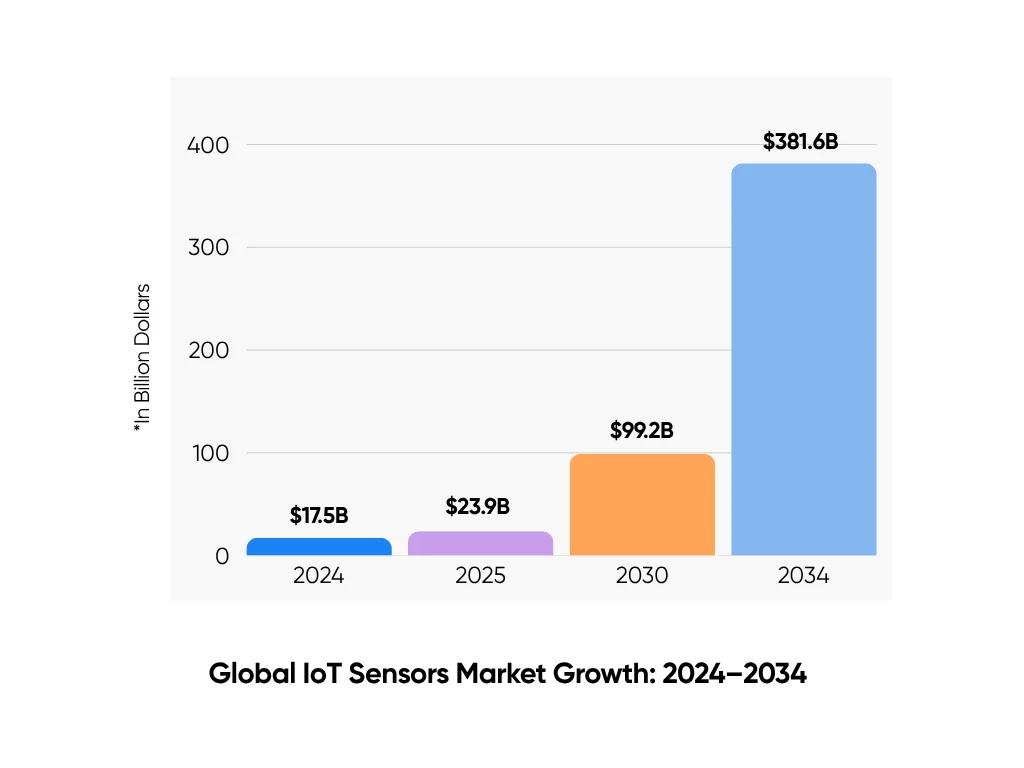
With this explosive growth to look forward to, let's now dive into the different types of IoT sensors:
Types of IoT Sensors
The use of IoT is one of the fastest emerging technologies nowadays. The IoT sensor landscape is diverse and widely used in healthcare, agriculture, the food industry, etc. Various types of sensors are based on their application and the data that needs to be collected.
The following are the most common types of IoT sensors.
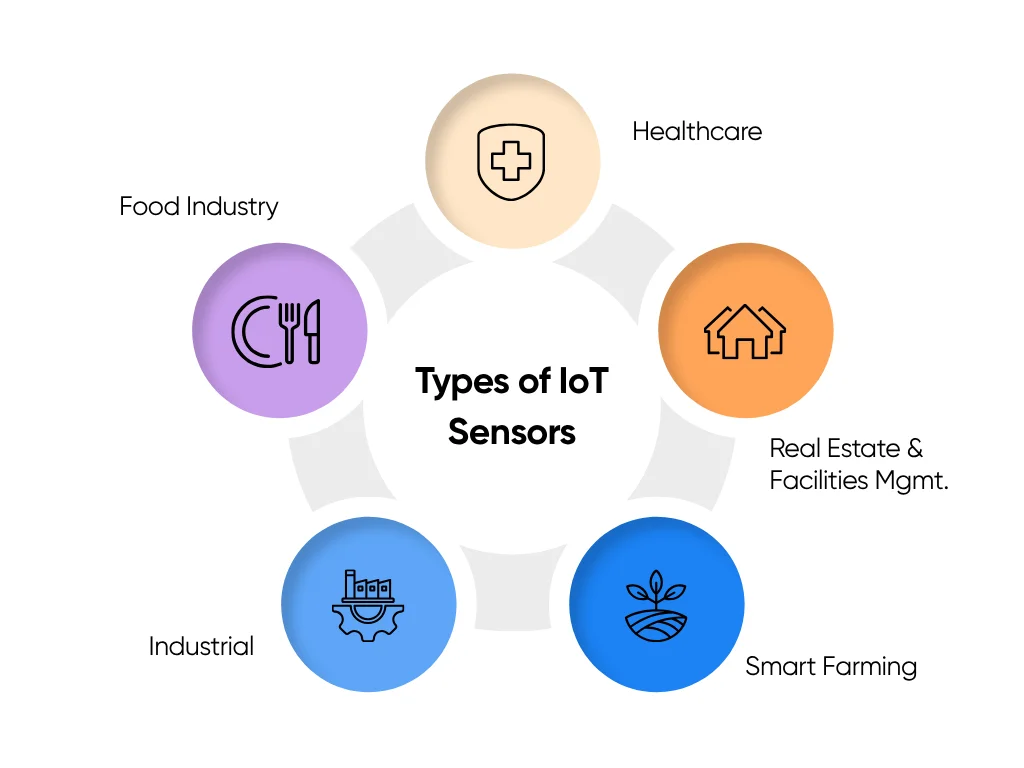
Healthcare IoT Sensor
In the healthcare industry, IoT sensors play a vital role in monitoring patients’ medications, vital signs, and other health conditions that can be stored and analyzed in the electronic health record (EHR) systems of hospitals and clinics. It also enables healthcare professionals to track their patient’s health remotely and diagnose them as early as possible.
Examples of these kinds of sensors can be implanted inside the human body (e.g., glucose monitoring sensors) or integrated through various medical devices (e.g., vital sign monitoring sensors) and wearable devices (e.g., activity and movement sensors commonly used in smartwatches). Either way, through these healthcare IoT sensors, healthcare professionals can immediately monitor and optimize treatments for patient safety.
IoT Sensors for Real Estate and Facilities Management
In real estate, sensors can collect data from various assets and equipment and offer real-time analysis, transforming the management industry. Using these sensors, we can monitor and improve the building's efficiency, reduce energy consumption, and increase the occupants’ comfort and well-being.
Integrated into devices and systems, these types of sensors detect energy usage and automatically analyze the gathered data to help reduce environmental footprint and energy costs (e.g., IoT Based Energy Monitoring System), as well as determine whether a room or space is occupied (e.g., Occupancy Sensors), and enhance home security (e.g., Security Sensors - motion sensors, temperature sensors, windows sensors, etc.).
IoT Sensors for Smart Farming
IoT for agriculture provides farmers with an efficient way to farm by detecting farming environments such as soil moisture, temperature, weather patterns, pest activity, and indications of crop health. With these types of sensors, monitoring crops can now be more accessible and allows the farmers to determine when to harvest or when the crops need more water and nutrients from fertilizers.
With the data collected by various sensors, the Internet of Things (IoT)-based Smart Plant Monitoring System tracks the growth of the plants, enabling farmers to optimize farm management for higher productivity and sustainability.
Industrial IoT Sensors
IoT sensors are used in industrial settings to automate processes and machines effectively by monitoring and gathering data from machinery and equipment. The data collected from sensors are utilized by businesses to monitor and control industrial processes continuously. With its durability, these sensors can withstand a changing industrial setting.
As a pivotal key in a digital era constantly changing in the industrial sector, industrial sensors allow businesses to use the benefits of its wireless connectivity, automation, and data-driven decision-making. Moreover, these sensors can also be integrated into maintenance systems, like how an IoT vibration sensor provides data on an industrial machine’s health and performance through vibration.
IoT Sensors in the Food Industry
With concerns for food safety, IoT devices like sensors have paved the way for the effective tracking of foods from farms to our table. Tracking where we get our food can have several impacts. It gives us better transparency and traceability in the food supply chain, ensuring food safety and quality. It also enables us to make more informed choices about our food sources, supporting sustainable and ethical practices.
Real-time tracking of food products also allows food businesses to verify food safety inspections. Food monitoring systems using IoT can further provide information about a product through data from sensors, such as its nutritional value, which customers can use to identify which meets their needs.
How Do You Implement the Use of IoT Sensors?
Implementing IoT sensors can be a complex process and requires specific expertise. We’ll go through the basics on a high level:
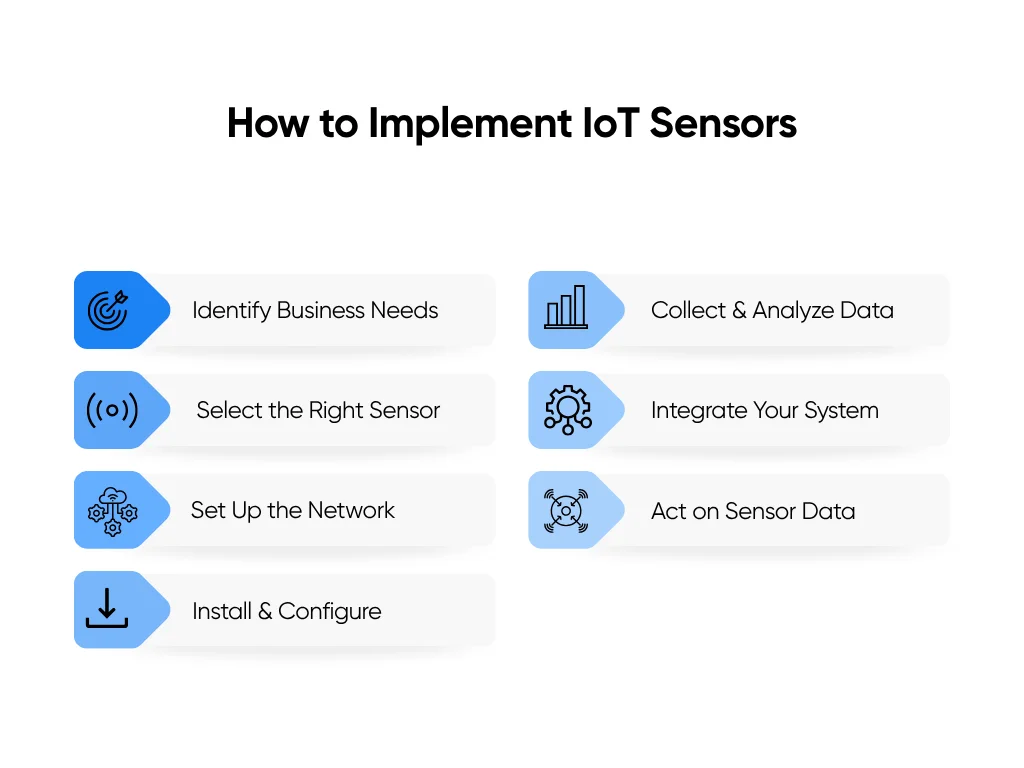
Step 1: Identify the Needs of Your Business or Project
Determine the specific data you need to collect and analyze to resolve your problems or achieve your goal. You must know what the required parameters are to achieve your goals. To identify your needs, here is a guide you can use:
- Define the objective through a clear outline of goals and identify the problem to be addressed.
- Identify the processes based on the kind of results you desire.
- Determine data requirements by identifying the type and volume of data that needs to be collected.
- Evaluate the connectivity options available.
- Identify the specific capabilities needed to collect the required data.
- Consider power requirements and how the sensors will be powered.
- Assess integration needs by considering how to collect the data and integrate it into your existing systems or applications.
Identifying your needs is vital to start the process because the process will depend on your evaluation of what your business or project needs.
Step 2: Select the Right Type of Sensor
Select the type of sensor that best suits your needs and environment. The right kind of sensor is crucial for accurate and reliable measurements. It ensures compatibility with the application and environmental conditions, optimizing costs and power consumption.
Choosing a sensor that matches the required precision and sensitivity will make the data collection more accurate and trustworthy. The suitable sensor type ultimately enables seamless integration, cost efficiency, future expansion, and upgrades.
Here are the things you need to consider when you select an IoT sensor:
- Define project requirements by knowing the kind of data to collect.
- Check compatibility and ensure the sensors are compatible with your IoT platform or network infrastructure.
- Assess cost-effectiveness by comparing the costs of different sensors, considering both upfront purchase and ongoing maintenance expenses.
Step 3: Set Up the Network
Create a reliable and secure network infrastructure to connect the sensors to the internet. To create a reliable and secure network, you must:
- Plan your architecture (scope and scale of your selected IoT sensor/s).
- Choose the proper protocol (Wi-Fi, Bluetooth, etc.)
- Implement strong authentication and encryption, segment the network, and deploy firewalls and monitoring systems.
- Apply regular updates and establish incident response procedures.
The procedures when setting up a network may still change depending on the type of IoT sensor/s, protocols, and network specifications used. Thus, it is highly recommended to ask for advice from IoT network specialists.
Step 4: Install and Configure the Sensors
When you install and configure, physically install them in the desired locations and configure them to collect the required data. Here are the steps to install and configure:
Identify the desired locations and select the appropriate sensor type.
- Prepare the installation environment and physically mount the sensors in their designated places.
- Test the sensors to ensure proper functionality and continuously monitor and maintain the sensor network for optimal performance.
- Ensure correct calibration and maintenance for accurate readings.
Step 5: Collect and Analyze the Data
To collect and analyze data, you must establish a system to receive and process the sensor data. This may involve using cloud platforms, edge computing, or dedicated software applications to store, analyze, and visualize the data.
Afterward, statistical techniques or machine learning algorithms are applied to analyze the data and generate meaningful insights. Create reports to summarize the findings, continuously monitor the sensor data, and refine your analysis techniques for ongoing improvement.
Step 6: Start Integrating your System
Integrate the sensor data with existing systems or applications to enable automation, decision-making, and control based on real-time information. With the help of IoT networking specialists, integrate the system through configuration and conduct various tests to ensure the integration implementation through data flow and system performance.
Step 7: Implement Actions Based on Sensor Data
Implement appropriate actions or triggers based on the insights gained from analyzing the sensor data. This can include automated responses, alerts, or notifications sent to relevant stakeholders.
IoT Sensors Use Cases
IoT sensors have many uses, including connecting physical devices to the digital world. Businesses use this feature to improve their productivity and efficiency.
Here’s how businesses and companies use IoT sensors in their daily operations:
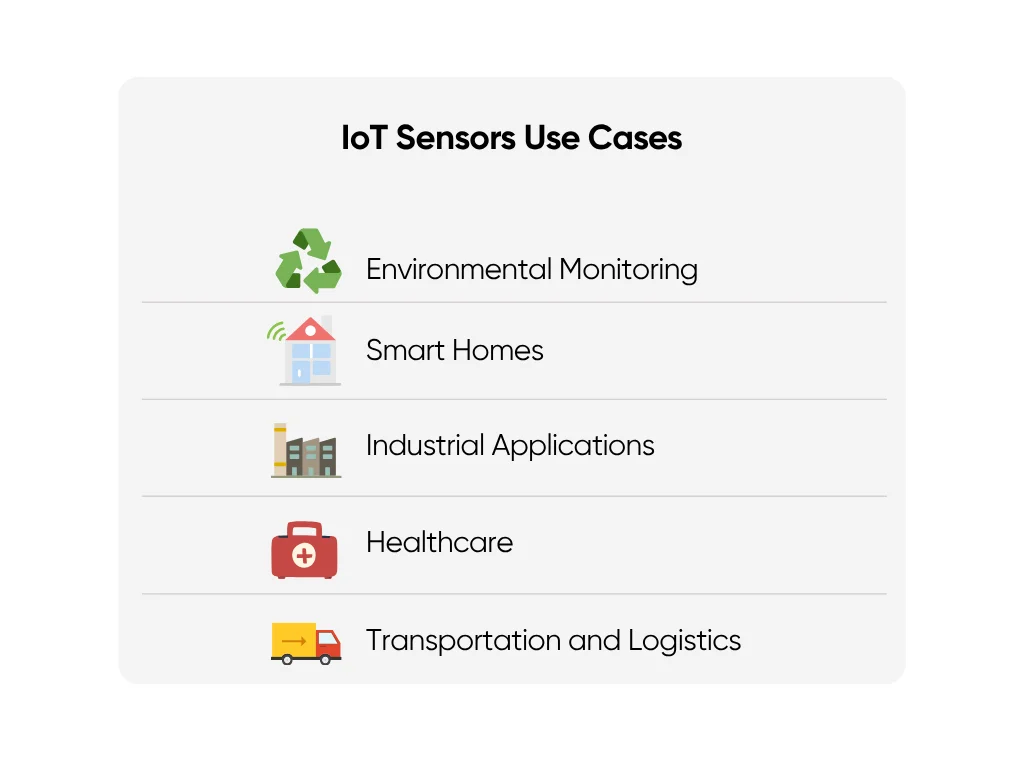
Environmental Monitoring
Environmental monitoring involves real-time recording of air quality, temperature, humidity, and pollution levels. This information is valuable for applications such as smart cities, agriculture, and industrial processes. Some examples of environmental monitoring include air quality monitoring, water quality monitoring, wildlife monitoring, and many more.
Smart Homes
Smart homes with smart sensors are residences with interconnected devices and sensors. These sensors collect and analyze data to automate and enhance home functionality. They enable remote control of security, energy management, environmental monitoring, home automation, health monitoring, and entertainment systems.
Industrial Applications
Manufacturing plants can monitor equipment health, detect faults, and optimize production processes with the help of IoT. Sensors gather data with the given parameters. The data gatherers can help in predictive maintenance, reducing downtime, and improving overall efficiency.
Healthcare
IoT sensors are vital in remote patient monitoring, wearable health devices, and intelligent medical equipment. They can track vital signs and medication adherence and provide real-time alerts to healthcare providers.
Transportation and Logistics
In transportation, sensors are used for fleet management, tracking goods in transit, and optimizing supply chain operations. They provide real-time visibility into vehicle location, temperature monitoring, and route optimization.
Notable Features of IoT Sensors
IoT Sensors offer various features that can be utilized. Still, its capability would depend on how it is further used to achieve the goals that you had set before. Also, determining such features would give you more information when selecting IoT sensors. How your business uses them depends on your industry and the target data to acquire.
Here are these notable features:
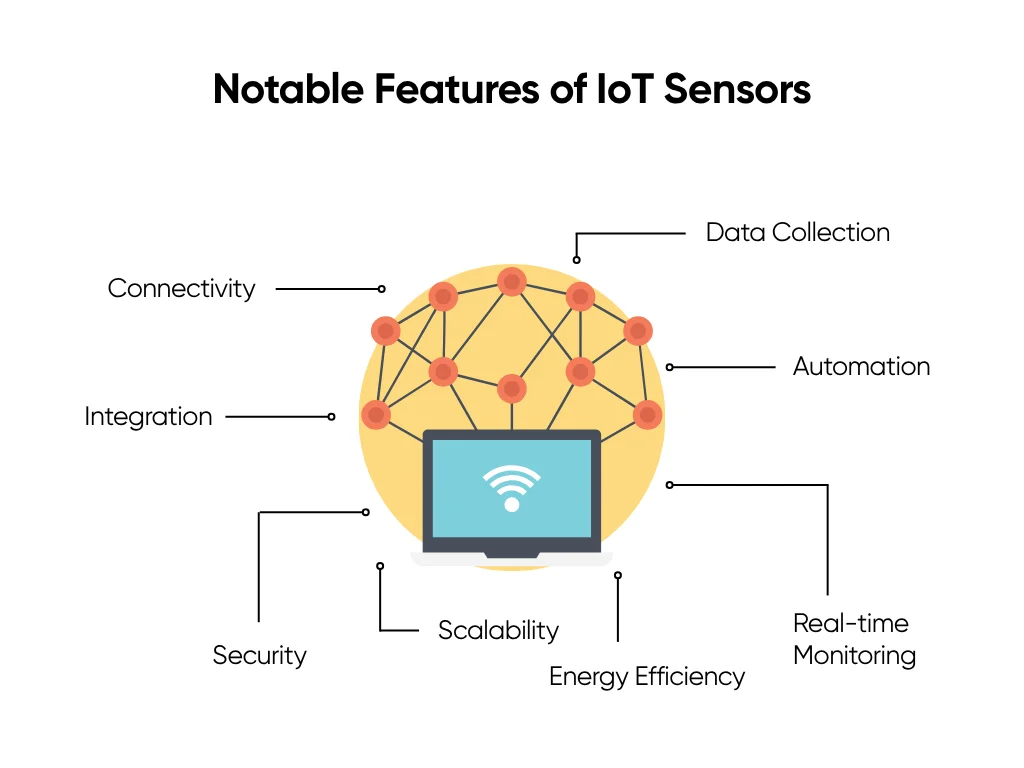
Connectivity
The core feature of IoT is connectivity. This means the establishment of a connection between various devices to maintain communication. In IoT, many devices like sensors, computers, and data buses interact and communicate.
Data Collection
Data gathering using smart sensors offers various advantages, such as accuracy and precise information in real-time. Also, it is cost-effective and can easily be analyzed due to data integration.
Automation
IoT automation integrates smart devices, sensors, and software systems to automate tasks within an IoT ecosystem. Automation makes the processes more manageable and more efficient by letting devices communicate with each other. Devices can share data and make choices without any human intervention.
Real-time Monitoring
Incorporating IoT devices to gather data can provide real-time information updates, allowing immediate actions and decision-making based on the collected information. When gathered, environmental data is instantly sent to a platform or system for processing and analysis. As a result, real-time monitoring guarantees that data is constantly flowing and that you always receive up-to-date information.
Energy Efficiency
IoT devices for data gathering are designed with low power consumption to prolong battery life or use energy harvesting techniques to power themselves. Thus, this feature allows them to perform and operate for a long time without recharging from time to time and enables them to be cost-effective and sustainable.
Scalability
Sensors in IoT networks can be easily expanded or scaled up to accommodate many devices and cover a wide area. The IoT sensors can exchange data effectively and efficiently for a continuous data flow. Moreover, IoT sensors can adapt to a changing environment and still perform efficiently.
Security
IoT sensors incorporate encryption and authentication mechanisms to ensure the security of data transmitted over the network. In IoT security, data privacy is a critical aspect. Regular security monitoring should be implemented along with multiple security practices under its guidelines.
Integration
IoT sensors can integrate with cloud platforms and analytics tools to process and analyze the collected data for insights and actionable intelligence. This enables data transmission and utilization more easily, and when designed to accommodate future growth of the network, the system could maintain a stable and effective performance for enhanced operational effectiveness and decision-making.
Benefits of IoT Sensors for Business
Nowadays, many businesses integrate IoT into their processes. Implementing it can help businesses, startups, and companies across various industries experience its benefits.
Here are the benefits of implementing IoT sensors for business:
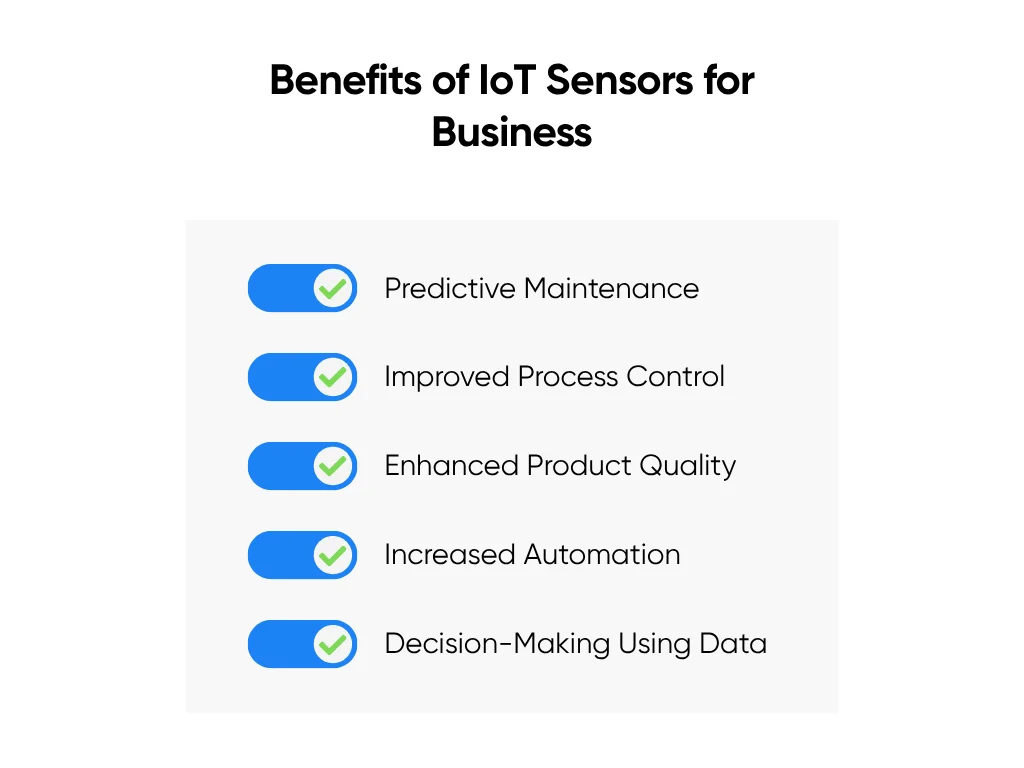
Predictive Maintenance
IoT devices like sensors enable predictive maintenance, allowing businesses to detect and prevent equipment failures before they occur. Through monitoring the condition of machines and systems in real-time, companies can schedule maintenance activities proactively, reducing downtime and maintenance costs.
Improved Process Control
Sensors are essential in industrial Internet of Things (IoT) systems by providing real-time data on various process variables. This data allows business owners to optimize production processes, improve quality control, reduce costs, and enhance operational efficiency for improved process control of real-time monitoring, process automation, and continuous improvement.
Enhanced Product Quality
It enables businesses to monitor and control environmental conditions, ensuring the quality and reliability of their products. By leveraging smart sensors to enhance product quality, companies can improve customer relations, meet user needs, and strengthen their business or startup, ultimately gaining a competitive edge.
Increased Automation
Increasing automation reduced the need for manual intervention and human error. By integrating sensors into production lines, businesses can achieve higher precision, efficiency, and productivity. The IoT sensor can be utilized for automated decision-making and remote monitoring through seamless communication between devices and systems. Thus, businesses and startups can immediately respond to environmental changes while being resourceful and innovative.
Decision-Making Using Data
With the data gathered from the sensors, business owners can use the analyzed results to make informed decisions. The real-time insights can help business owners optimize their existing processes, such as inventory management or identifying market trends. The data collected provides valuable inputs for strategic planning and business growth.
Key Takeaway
IoT sensors enable businesses to collect and analyze real-time data to improve efficiency and enhance productivity in their day-to-day operations. It reduces costs through automation and provides better customer experiences. Looking ahead to 2025, the integration of AI with IoT (AIoT), edge computing for faster local processing, and digital twins for virtual asset simulation are transforming how businesses leverage sensor data.
If you need comprehensive knowledge to streamline your projects using IoT sensors, Aloa offers wide information about various IoT sensors, plus AI consultancy services to help you implement cutting-edge AIoT solutions. Contact us today to get a custom quote for your project!
Frequently Asked Questions
What is the difference between a traditional sensor and an IoT sensor?
A traditional sensor collects data locally, often needing manual checks. An IoT sensor sends data automatically over a network. IoT sensors support remote monitoring and real-time alerts. They help you automate processes and gain insights quickly. This enables smarter decisions and better efficiency.
What are the main challenges or limitations when deploying IoT sensors?
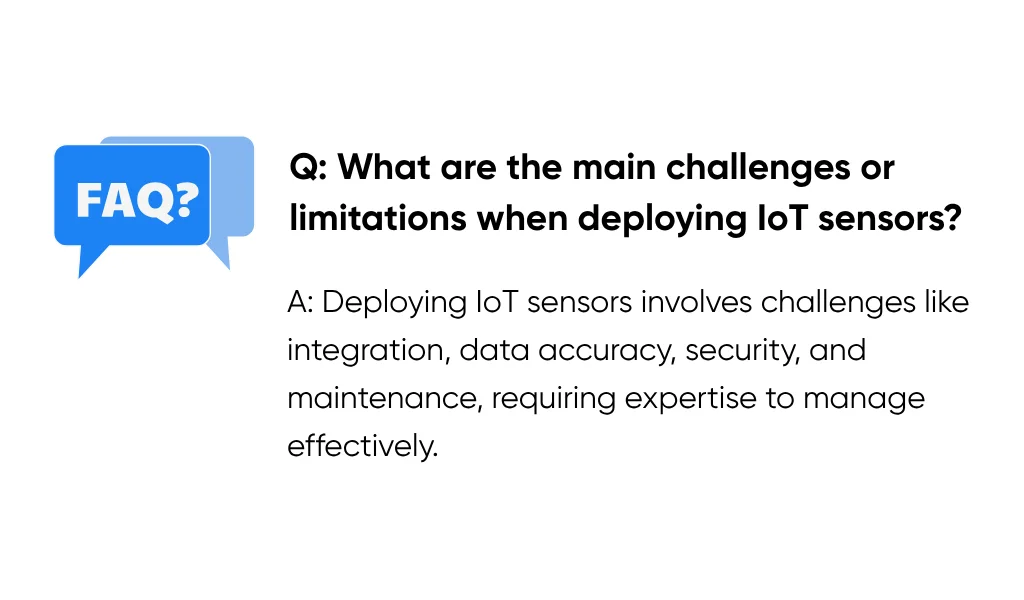
Deploying IoT sensors presents several challenges. Integration with existing systems can be complex. Data accuracy and reliability may vary. Security and privacy risks are real concerns. Maintenance and updates need planning. You need expertise to manage these risks well.
How do IoT sensors actually transmit data, and what are the common connectivity options?
IoT sensors send data using wired or wireless methods. Common options are Wi-Fi, Bluetooth, Zigbee, LoRaWAN, and cellular. The best choice depends on your range and power needs. Data goes to a gateway or directly to the cloud. This enables fast access and analysis.
How much do IoT sensors cost, and what factors influence their pricing?
IoT sensor prices have dropped significantly in recent years, with individual sensors priced at as low as $0.44. Your cost depends on the sensor type, features, and durability.
If you’re considering developing your own IoT sensors, we recommend starting with a PoC that can range from $10,000 to $20,000. The design and implementation of your hardware and software will make up the bulk of your total cost.
What are the most important criteria for selecting the right IoT sensor for my application?
Focus on accuracy, compatibility, and power use first. Check if the sensor suits your environment. Look at security features and data speed. Make sure it works with your existing systems. Consider vendor support and the full cost of ownership.
How can I ensure the security and privacy of data collected by IoT sensors?
Use strong encryption and secure authentication for all data. Update firmware and software regularly. Limit access to only trusted users. Monitor sensor data for unusual activity. Choose vendors with a strong security record and privacy policies.

